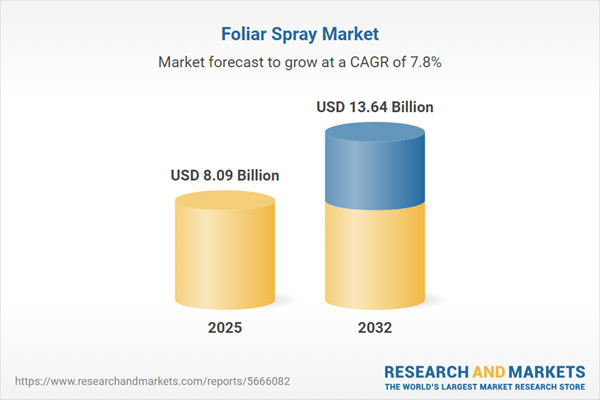Speak directly to the analyst to clarify any post sales queries you may have.
Senior executives operating within the United States foliar spray market are navigating a period of substantial change. Driven by shifting regulations, rapid technological development, and heightened sustainability expectations, this sector demands informed, adaptable leadership to sustain growth and competitiveness.
Market Snapshot: United States Foliar Spray Market
The United States foliar spray market is exhibiting strong growth, fueled by widespread adoption of precision agriculture practices. Digital innovations are reshaping how decision-makers approach field management, supply sourcing, and product delivery. Capital is flowing into the crop protection segment, while operational strategies are being realigned to enhance efficiency and resilience. Organizations across the supply chain are focusing on agile approaches that accommodate both regulatory compliance and evolving customer requirements. Collaboration across domestic and global entities is fostering a unified movement toward technology-driven, data-informed operations in U.S. agriculture.
Scope & Segmentation
- Crop Types: The report analyzes cereals and grains, fruits and vegetables, oilseeds and pulses, and turf and ornamentals, reflecting the range of U.S. agricultural priorities and aiding in comprehensive product alignment for growers.
- Product Types: Examination covers granular, liquid, and soluble powder formats, acknowledging the importance of tailored application methods in modern farm operations.
- Functions: Assessment includes biostimulants, NPK fertilizers, micronutrient blends, and pesticides, empowering businesses to address both crop nutrition and pest management with precision.
- Application Methods: Includes aerial and ground spraying, each supporting different operational efficiencies and levels of application accuracy across diverse field environments.
- Formulations: Emulsifiable concentrates, soluble liquids, suspension concentrates, and wettable powders are evaluated for their role in enhancing versatility and regional adaptation.
- Distribution Channels: Direct-to-farm sales, distributor-led models, and digital commerce platforms are compared for their capability to ensure responsive service delivery and market reach.
- Nature: The study considers both conventional and organic practices, emphasizing evolving regulations and the shift toward sustainable options.
- Regional Coverage: While focused on the United States, the report integrates benchmarking from Europe, Asia-Pacific, the Middle East, and Africa to provide multinational organizations with comparative insights for strategy development.
- Major Companies: Strategic approaches and innovations from BASF SE, Bayer AG, Corteva, Syngenta AG, FMC Corporation, UPL Limited, Nufarm Limited, ADAMA Agricultural Solutions Ltd., Yara International ASA, and Isagro S.p.A are reviewed, showcasing leadership trends in the foliar spray sector.
Key Takeaways for Senior Decision-Makers
- Integrating advanced foliar spray solutions creates agility, enabling organizations to adapt quickly to regulatory and customer landscape shifts.
- Deployment of digital technologies—such as field sensors and analytics—support improved resource management and progress on sustainability priorities.
- Growing demand for biostimulant and organic offerings compels organizations to strengthen supplier relationships and compliance processes.
- Partnerships within the agri-tech ecosystem convert operational data into strategic insights, supporting more informed and timely decision-making.
- Adapting products regionally helps align offerings with local regulatory, climatic, and agronomic variables, supporting a tailored approach to market requirements.
- Regular benchmarking and agricultural analytics support sustained competitiveness and help organizations respond to changing policy conditions.
Tariff Impact: Navigating Supply Chain Challenges
Recent tariff changes impacting foliar spray ingredient imports have driven companies to reevaluate procurement approaches. Priority is now given to reinforcing local and regional supplier networks, minimizing risk exposure and improving flexibility. Investments in customs management processes and the diversification of supplier bases are standardizing as strategies to support resilience and uphold continuity against ongoing policy changes in the market.
Methodology & Data Sources
The findings are based on a combination of qualitative and quantitative information drawn from direct interviews with key stakeholders across the foliar spray value chain, including growers, distributors, and technical experts. Data validation is supplemented through regulatory documents, patent filings, and academic research. Proprietary analytics platforms translate these inputs into actionable management strategies for senior executives.
Why This Report Matters
- Offers benchmarking that aids executive teams in allocating capital and refining competitiveness strategies as the United States foliar spray market develops.
- Enables stronger compliance and risk management, enhancing readiness for shifts within both conventional and organic agriculture segments.
- Guides portfolio alignment with the critical goals of sustainability and operational resilience, keeping organizations ahead of evolving agricultural trends.
Conclusion
Focused planning and responsiveness will allow senior leaders to anticipate changes in the foliar spray sector. Strategic agility and comprehensive supply chain strategies will remain vital as industry transformation continues.
Additional Product Information:
- Purchase of this report includes 1 year online access with quarterly updates.
- This report can be updated on request. Please contact our Customer Experience team using the Ask a Question widget on our website.
Table of Contents
3. Executive Summary
4. Market Overview
7. Cumulative Impact of Artificial Intelligence 2025
Companies Mentioned
The companies profiled in this Foliar Spray market report include:- BASF SE
- Bayer AG
- Corteva, Inc.
- Syngenta AG
- FMC Corporation
- UPL Limited
- Nufarm Limited
- ADAMA Agricultural Solutions Ltd.
- Yara International ASA
- Isagro S.p.A.
Table Information
| Report Attribute | Details |
|---|---|
| No. of Pages | 186 |
| Published | November 2025 |
| Forecast Period | 2025 - 2032 |
| Estimated Market Value ( USD | $ 8.09 Billion |
| Forecasted Market Value ( USD | $ 13.64 Billion |
| Compound Annual Growth Rate | 7.7% |
| Regions Covered | Global |
| No. of Companies Mentioned | 11 |









